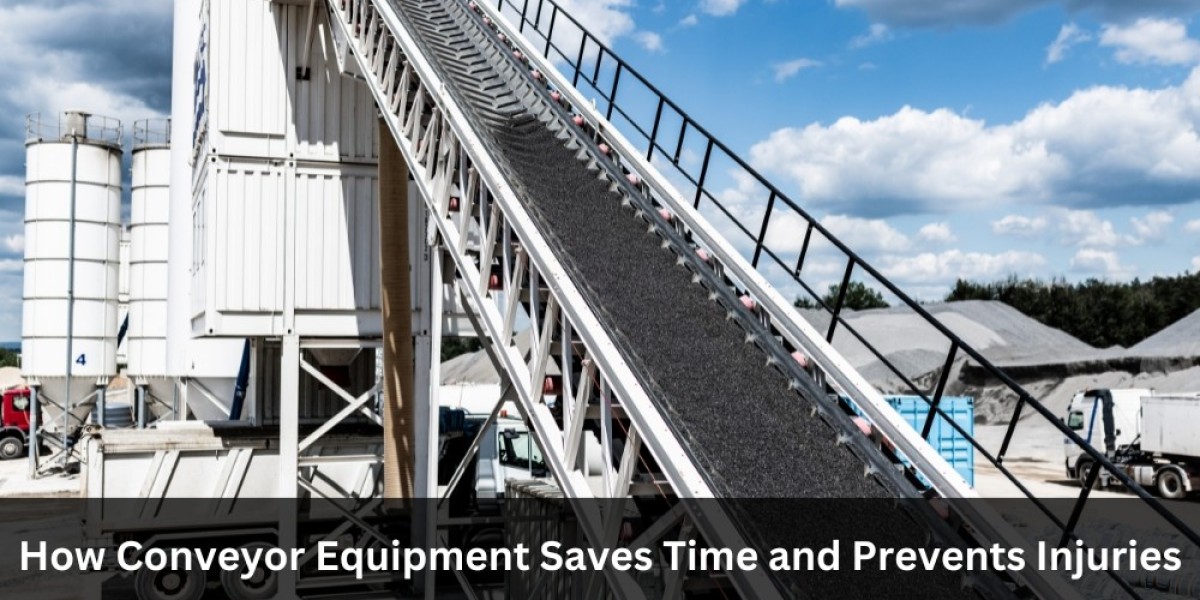Still moving stock by hand? It might be costing you more than you think
Whether it’s a warehouse, construction yard, or production line, the way you move materials matters. If your crew is still pushing trolleys, lifting crates, or dragging gear by hand, chances are you’re bleeding time and riskig injury. The solution? Investing in the right conveyor equipment.
I’ve worked on sites where everything was manual. It looked “cheap” on paper — until staff got injured, productivity dipped, and jobs started backing up. Switching to conveyors changed the game not just for safety, but for speed, consistency, and morale.
Let’s break down how this humble bit of kit can revolutionise how your operation runs.
Why time matters in material handling
Time isn’t just money. It’s margin. It’s crew fatigue. It’s how many jobs you can realistically take on without burning out or stuffing up deliveries.
When you use conveyors:
You keep materials flowing at a steady rate
You reduce waiting times between tasks or departments
You cut out the need to reposition forklifts or trolley lanes
You allow teams to focus on skilled tasks, not grunt work
I saw this firsthand on a job fitting out a packaging facility. Manual transfers between packing stations were holding everything up. We installed a straight-run roller conveyor between each zone. Result? Same crew, same gear, 22% faster output.
The cost of injury from manual lifting
Here’s the harsh truth: the most common injuries in warehouses and trades come from overuse and poor lifting.
Every time someone lifts a box, a pipe, or a panel, there’s a risk, especially if they’re rushing, twisting, or pushing too much weight. That’s why conveyors aren't just efficiency tools. They're safety equipment.
Safe Work Australia highlights the serious risks that come with lifting, pushing, and pulling manual tasks, especially in high-volume, fast-paced environments. These risks can be drastically reduced by replacing repetitive manual handling with mechanical assistance like conveyors.
Common issues include:
Back strain from lifting awkward loads
Shoulder injuries from repetitive lifting
Hand and finger crush points during uncontrolled movement
Slips and trips from pushing or pulling loads without control
Less lifting = less risk.
Where conveyors shine (and where they don’t)
There’s no one-size-fits-all system, but most conveyor equipment falls into a few main categories:
Belt conveyors: Ideal for the continuous movement of small or fragile items
Roller conveyors: Best for boxes, crates, or any flat-bottomed load
Chain-driven or heavy-duty models: Great for building materials, pallets, or machinery
Incline conveyors: Help move items between different heights or platforms
They work brilliantly in:
Warehouses
Manufacturing lines
Packing stations
Vehicle loading zones
Recycling and waste processing sites
Where don’t they work as well? Places with irregular, uneven terrain or high water exposure — unless you’re using a waterproof, corrosion-resistant system.
If you're scaling up an automated floor plan, you’ll also want to look into automated warehouse systems that integrate with conveyor setups.
Real example: saving time and protecting backs
A mate of mine manages a parts distribution centre. For years, staff were unloading delivery trucks with pallet jacks, then breaking boxes and sorting manually at each station.
It worked — but slowly. Then a team member strained their back lifting from a low trolley. Workers’ comp, light duties, and delays followed.
They brought in a flexible roller conveyor system with height adjustment and braking control. It meant they could roll boxes straight from the dock to the first pick zone, no lifting required. It cut down unloading time by 40%, and the injury rate dropped to zero for the next 18 months.
Small crews, big gains
You don’t need to run a warehouse to justify conveyors.
In smaller operations, conveyor equipment acts as an extra set of hands. You can:
Move heavy items solo without calling for backup
Set up material staging zones
Keep the workflow going even when someone’s off sick
Load and unload trucks faster, without an extra crew
And because many systems are modular, you can build as you go. Start with a 3m roller set. If things grow, add another curve, a ramp, or a powered section later.
Choosing the right conveyor system
Before you buy, consider:
Load type: What are you moving? Boxes, loose parts, odd shapes?
Weight: Heavier loads need stronger frames and rollers
Speed: Are you feeding an automated system or working manually?
Space: Measure your floor layout. Account for curves, corners, and access paths.
Work zone: Is it dusty, wet, or outdoors? You’ll need different materials or finishes.
Don’t forget about height—adjustable legs or incline sections that help match existing benches or docks.
And always check what’s available locally. CHS, for example, stocks full conveyor equipment kits and can provide guidance based on your industry.
Not just for big business: conveyors in trades and construction
Tradies and contractors often assume conveyors are for mega-warehouses. But you’d be surprised how much time they save on-site.
Installing a conveyor to move tile boxes, timber, or rubble on multi-level builds? Huge labour saver.
On demo jobs or tight renovation spaces, mini conveyors let you transport material from interior rooms to outdoor skips, reducing mess and keeping paths clear.
For roofing or solar installs, inclined conveyors or ladder hoists help move panels and tools without risky climbs.
Conveyors aren’t just for shipping — they’re for smart handling in tight, awkward, or high-volume workflows.
Ongoing use: maintenance, servicing and reliability
Like any piece of machinery, conveyor systems work best when they’re looked after.
Keep things running smoothly by:
Cleaning belts and rollers regularly
Checking for alignment or frame warping
Lubricating moving parts and bearings
Replacing damaged sections before they become hazards
Having a spare set of wear parts (rollers, belts, brackets) on hand
Local support matters too. Pick a supplier with a solid service network, not just online sales. If your conveyor fails mid-job, you want help now, not next Thursday.
Bonus resource: Want to get even more out of your setup?
Conveyors are part of a broader world of efficient logistics. If you’re ready to optimise even further, check out this great read on material handling best practices. It covers layout planning, ergonomics, and ways to minimise handling steps.
Every step your team doesn’t need to take — physically or logistically — is a win.
Final thoughts
The right conveyor equipment doesn’t just shift stock. It changes how your business operates.
You’ll reduce injuries, save time, and boost the flow of work across your site — whether that’s a full-blown warehouse or a scrappy on-site setup.
In this industry, margins are tight, deadlines are tighter, and safety is non-negotiable. If you’re still relying on muscle power, maybe it’s time to let your gear do the heavy lifting for once.








